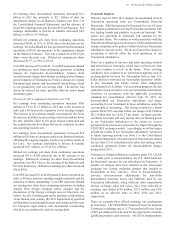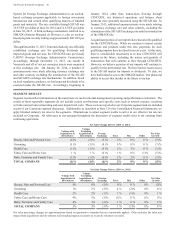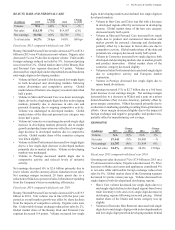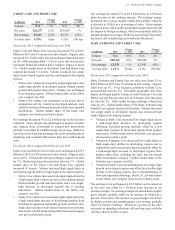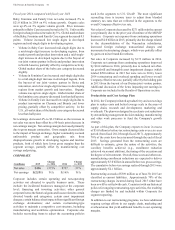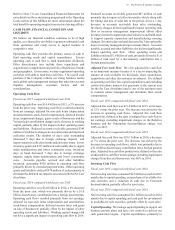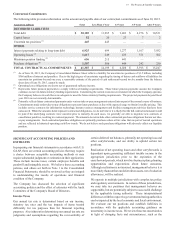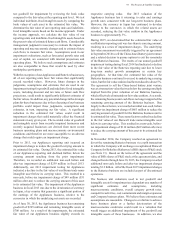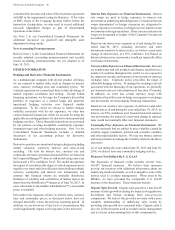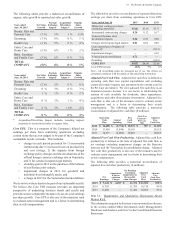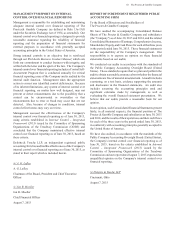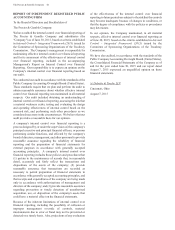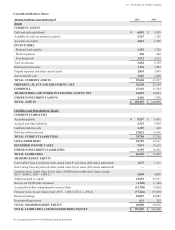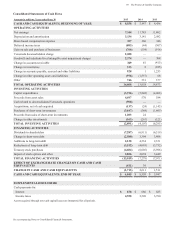Proctor and Gamble 2015 Annual Report Download - page 41
Download and view the complete annual report
Please find page 41 of the 2015 Proctor and Gamble annual report below. You can navigate through the pages in the report by either clicking on the pages listed below, or by using the keyword search tool below to find specific information within the annual report.39 The Procter & Gamble Company
test goodwill for impairment by reviewing the book value
compared to the fair value at the reporting unit level. e test
individual indefinite-lived intangible assets by comparing the
book values of each asset to the estimated fair value. e
determine the fair value of our reporting units and indefinite-
lived intangible assets based on the income approach. Under
the income approach, we calculate the fair value of our
reporting units and indefinite-lived intangible assets based on
the present value of estimated future cash flows. Considerable
management judgment is necessary to evaluate the impact of
operating and macroeconomic changes and to estimate future
cash flows to measure fair value. Assumptions used in our
impairment evaluations, such as forecasted growth rates and
cost of capital, are consistent with internal projections and
operating plans. e believe such assumptions and estimates
are also comparable to those that would be used by other
marketplace participants.
ith the exception of our Appliances and atteries businesses,
all of our reporting units have fair values that significantly
exceed recorded values. However, future changes in the
judgments, assumptions and estimates that are used in our
impairment testing for goodwill and indefinite-lived intangible
assets, including discount and tax rates or future cash flow
projections, could result in significantly different estimates of
the fair values. In addition, any potential change in the strategic
plans for these businesses due to the refocusing of our business
portfolio could impact these judgments, assumptions and
estimates, in turn, impacting our fair value. A significant
reduction in the estimated fair values could result in
impairment charges that could materially affect the financial
statements in any given year. The recorded value of goodwill
and intangible assets from recently impaired businesses and
recently acquired businesses are derived from more recent
business operating plans and macroeconomic environmental
conditions and therefore are more susceptible to an adverse
change that could require an impairment charge.
Prior to 2013, our Appliances reporting unit incurred an
impairment charge to reduce the goodwill carrying amount to
its estimated fair value. During 2013, the estimated fair value
of our Appliances reporting unit declined further, below the
carrying amount resulting from the prior impairment.
Therefore, we recorded an additional non-cash before and
after-tax impairment charge of $259 million in fiscal 2013.
Additionally, our 2013 impairment testing for Appliances
indicated a decline in the fair value of our raun trade name
intangible asset below its carrying value. This resulted in a
non-cash, before-tax impairment charge of $49 million ($31
million after-tax) to reduce the carrying amount of this asset
to its estimated fair value. The impairment of the Appliances
business in fiscal 2013 was due to the devaluation of currency
in Japan, a key country that generates a significant portion of
the earnings of the Appliances business, relative to the
currencies in which the underlying net assets are recorded.
As of June 30, 2015, the Appliances business has remaining
goodwill of $299 million and remaining intangible assets of
$706 million. As a result of the impairments, the estimated
fair value of our Appliances business slightly exceeds its
respective carrying value. Our 2015 valuation of the
Appliances business has it returning to sales and earnings
growth rates consistent with our long-term business plans.
However, the currency in Japan has continued to devalue
relative to the currencies in which the related assets are
recorded, reducing the fair value cushion in the Appliances
business to approximately 5.
During 2015, we determined that the estimated fair value of
our atteries reporting unit was less than its carrying amount,
resulting in a series of impairment charges. The underlying
fair value assessment was initially triggered by an agreement
in September 2014 to sell the China-based battery joint venture
and a related decision to pursue options to exit the remainder
of the atteries business. The results of our annual goodwill
impairment testing during fiscal 2014 had indicated a decline
in the fair value of the atteries reporting unit due to lower
long-term market growth assumptions in certain key
geographies. At that time, the estimated fair value of the
atteries business continued to exceed its underlying carrying
value, but the fair value cushion had been reduced to about 5.
The agreement to sell the China-based battery joint venture
was at a transaction value that was below the earnings multiple
implied from the prior valuation of our atteries business,
which effectively eliminated our fair value cushion. As a result,
the remaining business unit cash flows no longer supported the
remaining carrying amount of the atteries business. Due
largely to these factors, we recorded an initial non-cash, before
and after-tax impairment charge of $863 million to reduce the
carrying amount of goodwill for the atteries business unit to
its estimated fair value. These same factors resulted in a decline
in the fair value of our Duracell trade name intangible asset
below its carrying value. This resulted in a non-cash, before-
tax impairment charge of $110 million ($69 million after tax)
to reduce the carrying amount of this asset to its estimated fair
value.
In November 2014, the Company reached an agreement to
divest the remaining atteries business via a split transaction
in which the Company will exchange a recapitalized Duracell
Company for erkshire Hathaway's (H) shares of P&G stock
(see Note 13). ased on the terms of the agreement and the
value of H's shares of P&G stock at the agreement date, and
changes thereto through June 30, 2015, the Company recorded
additional non-cash, before and after-tax impairment charges
totaling $1.2 billion. All of the fiscal 2015 impairment charges
in the atteries business are included as part of discontinued
operations.
The business unit valuations used to test goodwill and
intangible assets for impairment are dependent on a number of
significant estimates and assumptions, including
macroeconomic conditions, overall category growth rates,
competitive activities, cost containment and margin expansion
and Company business plans. e believe these estimates and
assumptions are reasonable. Changes to or a failure to achieve
these business plans or a further deterioration of the
macroeconomic conditions could result in a valuation that
would trigger an additional impairment of the goodwill and
intangible assets of these businesses. In addition, we also


